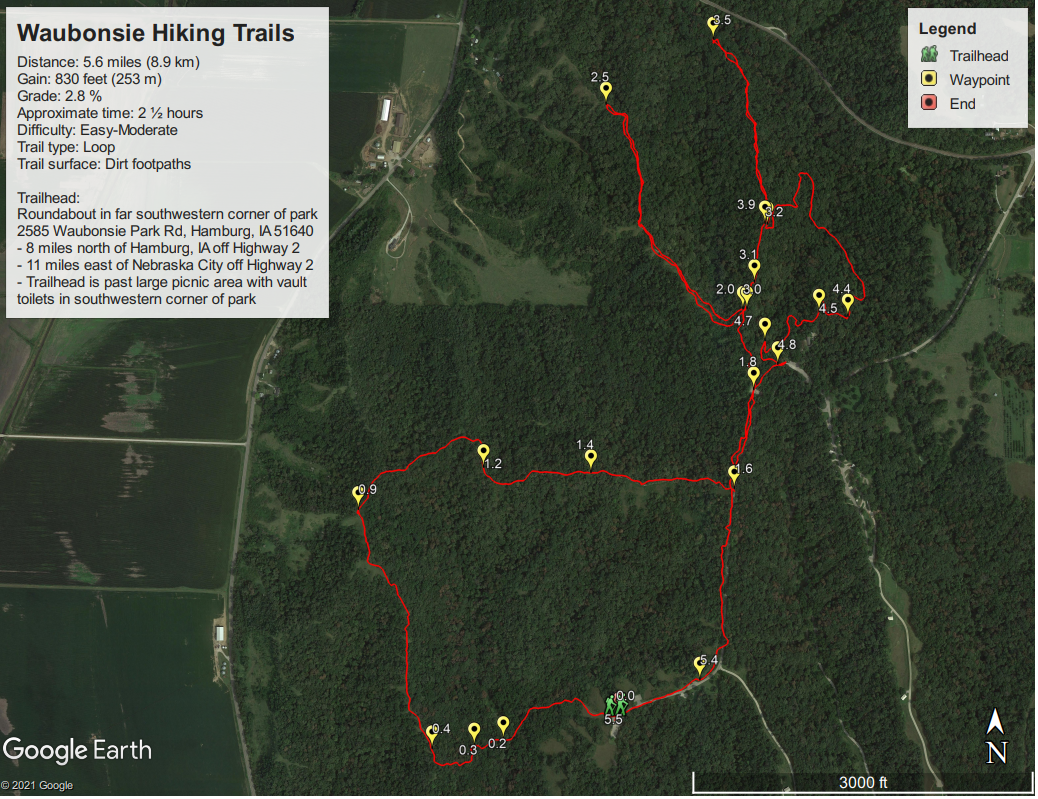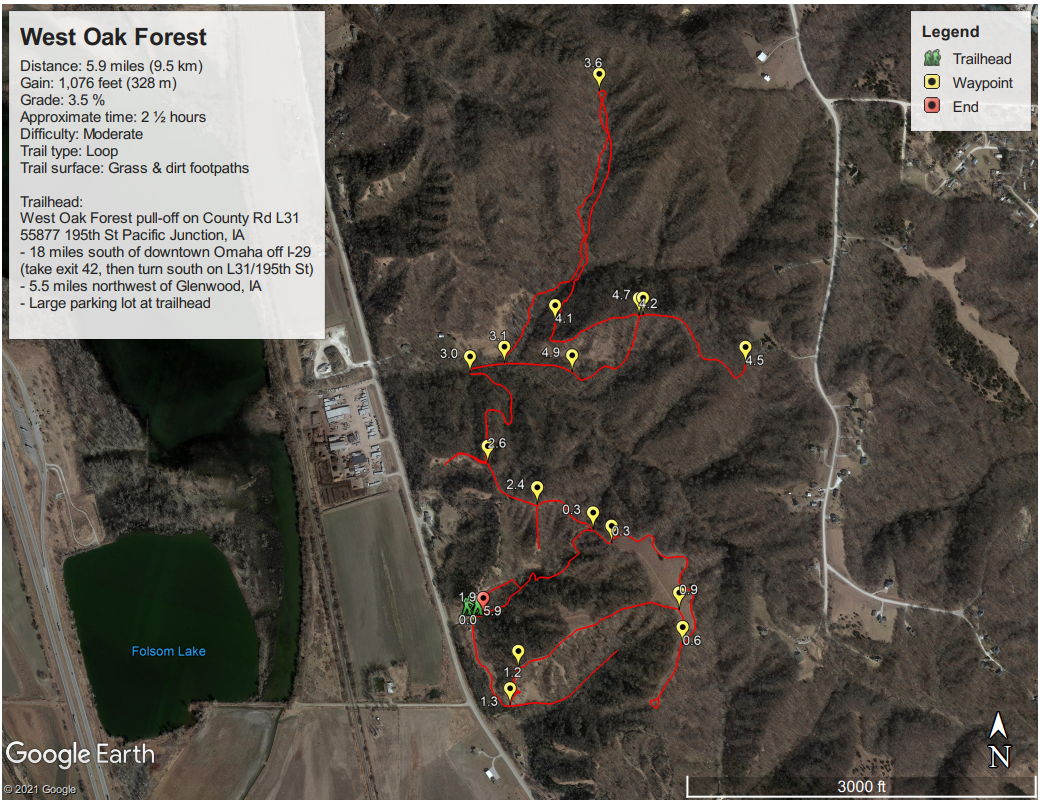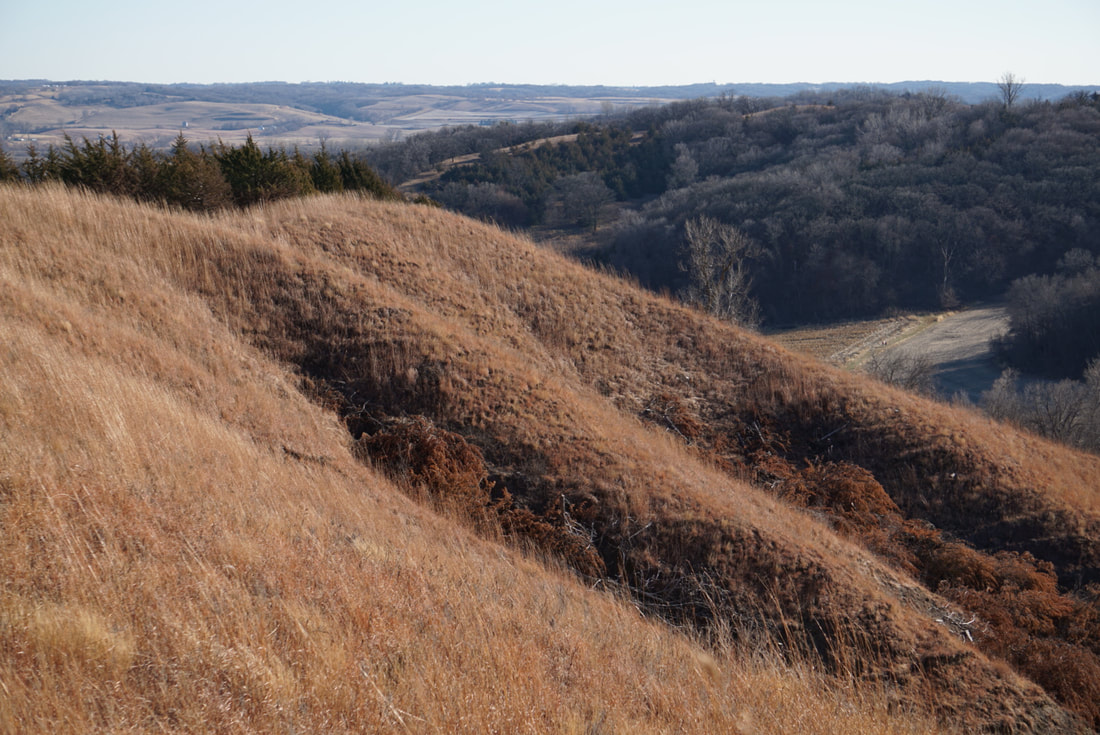|
by Seth Brooks Fall is the best time to hike in the Loess Hills: temperatures are cool, humidity is low, insects are largely gone, and a mosaic of red, yellow, and brown paint the hillsides. According to the Iowa DNR, this week the southern Loess Hills should reach peak color. The forecast for the last weekend of October looks perfect for a leaf-peeping hike on any of the publicly accessible lands in southwestern Iowa. While the wind and rain that swept across Nebraska and Iowa this week will have knocked off some leaves, the precipitation could give rise to another wonder of fall: mushrooms! It will be difficult to keep your eyes on the colorful canopy when fantastic fungi are fruiting from the forest floor. Put on a jacket, grab your hiking boots, bring a basket, and go hiking this weekend! Waubonsie State Park, named for Chief Waubonsie of the Pottawattamie tribe, is perhaps the best place to soak in the fall forest atmosphere. The park, one hour south of Omaha just off Interstate 29, is divided into two sections divided by Highway 2. The northern section has multi-use trails and is frequented by horseback riders. We will focus on the southern section of the park as its trails are open only to hikers. Sunset Ridge Trail is the park’s main trail, taking in sweeping vistas of the Missouri River Valley and diving into hardwood hollows. If you combine Sunset Ridge with Mincer Trail, you can make a nice 2.5-mile loop. However, three other trails--Ridge, Bridge, and Valley--are also worth your time. Linking them all together via the Overlook Trail is about six miles round-trip (there are trail maps available at the park, so feel free to make up your own hike). The ideal trailhead to start at is in the southwestern corner of the park. The trail immediately descends into a hollow only to steeply climb up a ridge. This climb could be slippery after rain. If so, hiking poles are recommended. Follow this ridge north with great views of the Missouri River Valley on your left. Recently installed interpretative panels provide information on the Loess Hills region. The trail turns east after half a mile but continues along the ridgetop. After a little more than half a mile, you will have a decision to make. Turn south to follow Mincer Trail and then the park road back to the trailhead. If you have more energy—or your mushroom basket is not yet full—continue north following Overlook Trail. You will pass a shelter and viewpoint before reaching a fork: left follows Ridge Trail, right Bridge Trail. Both are excellent choices and mostly shaded, so keep your eyes peeled for mushrooms pushing through the forest floor. Ridge Trail is exactly that: it stays atop a ridge which gives you great views back towards Sunset Ridge Trail. This is an out and back, so feel free to turn around at any time. Bridge Trail is also a pleasant walk but does have a descent toward the end. However, this area might be prime mushroom foraging. You will have to climb back up the ridge as Bridge Trail is also an out and back. As you return, you have the option on your left to follow Valley Trail. This trail descends into a hollow and then climbs back up behind the park office before connecting with Overlook Trail. From here, you can follow Overlook and Mincer trails and then the park road back to the trailhead. Whichever trails you follow, Waubonsie State Park will surely provide you a vigorous yet refreshing fall hike. Another excellent option for fall colors is West Oak Forest, eight miles northwest of Glenwood, Iowa, and managed by the Mills County Conservation Board. While not as large as Waubonsie, West Oak Forest does not lack enchanting woods to explore. The most used and best marked trails are in the southern part of the forest. It is a steep climb from the parking area, but once you reach the top, you are rewarded with typical Loess Hills topography of hilltop prairie, both remnant and restored, and hardwood forest in the hollows and ravines below. As you follow the trail to the south, take the spur trail heading west to a wonderful lookout point with views of the Missouri River Valley. There are some beautiful, twisted bur oaks along the trail to the lookout point. There is a steep path that leads down from the viewpoint, but this would not be recommended after recent rains. Instead, turn around and head back to the main trails along the ridge. The best part of West Oak Forest, in my opinion, is the trails in the northern section of the park. I wandered this section in May, so my memory might betray me, but there are fewer trail markers here, making it easy to get lost along the several trails that go deeper and deeper into the forest. Just remember how to get back, which includes a nice climb to get your heart rate going after a leisurely stroll in the forest. Nearby, both Mile Hill Lake and Pony Creek Park are other stellar options to enjoy what looks to be a splendid fall weekend. And if you forage for mushrooms: if you cannot identify it, don’t eat it.
0 Comments
By Seth Brooks Today, let’s go on a hike through the northern section of the Little Sioux unit of the Loess Hills State Forest. This is my favorite hike in all of the Loess Hills for a variety of reasons. The distance (6.5 miles) is perfect for a day hike, there are some inclines to get your heart rate pumping, and the terrain covered is a perfect representation of today’s Loess Hills. The trailhead, a fifty-minute drive from Omaha, is located at 1369 Geneva Place near Pisgah, Iowa, in the Soldier River Valley. There is ample parking and a picnic shelter at the trailhead. As with all state forest land, keep in mind hunters also use the land so check if it’s hunting season and wear appropriate clothing. The trail begins behind the picnic shelter and briefly parallels the road before reaching a farmhouse. After passing the farmhouse, you’ll see a pond to your right and an open field before you. At the time of writing this blog post (October 8, 2021), there was a fence crossing the trail and cattle grazing in the field. Since this trail is on state forest land, hikers should have access; just remember to close the fence behind you and take precautions if any cattle are near the trail. This fence was not here during the winter and spring of 2020/2021 and the cattle were penned up near the farmhouse, so perhaps in a few weeks the fence will be gone. As we continue hiking, the trail climbs steadily through the open meadow. As the trail enters a wooded area, it climbs steeply to reach the top of a ridge. This area appears to once have been farmed with row crops but is now restored prairie. If you have a field guide, take some time to identify the various prairie grasses. Follow the trail atop the ridge for 0.3 mile until you reach a trail descending on your left (a trail marker used to mark this junction but was absent as of October 2021). Continue straight atop the ridge (you will loop back to this junction as you return to the trailhead to finish the hike). Keep to your left at a fork--the trail is slightly obscured by an eastern redcedar at the fork. Soon you will pass an unmarked trail on your right that leads to a stand of pine trees. If you are curious about the pines, take the trail leading through the pine grove but return to the trail you have been following. There are signs of a recent fire that has stripped the pines of the needles on lower branches and turkey tail mushrooms growing on the forest floor. Back on the trail, at the two-mile point of the hike, the trail intersects with Brent’s Trail. Turn left to follow the trail markers for Brent’s Trail (shaped like bur oak leaves) but only for 0.2 mile. When you reach a fork, leave Brent’s Trail by taking the right fork that descends down the hillside to a beautiful mixed grass prairie below the ridge. The grass here, if not recently cut, grows to over five feet. Look across the meadow on the opposite hillside: perhaps you’ll see whitetail deer foraging. As you approach Fulton Avenue, turn left at an unmarked junction to climb back up to the top of the ridge (you can avoid this climb by staying atop the ridge and following Brent’s Trail, but you will miss the beautiful mixed grass prairie). Once you’ve climbed back atop the ridge, you have two options: turn right to head due southeast following Brent’s Trail along the ridge; or take a shortcut, avoiding the ridge, and continue straight to descend to the field on the east side of the ridge. This second option cuts one mile off the total distance of the hike. I recommend following Brent’s Trail along the ridge until it descends through redcedars and arrives at an open field. There is a parking area near where you can rest under a large cottonwood. However, before reaching the parking area, turn north to hike along the western edge of the field for a half mile. You’ll arrive at a fork and keep right as the trail heads east to climb up a ridge and the junction that was described earlier to return to the trailhead. It’s 1.5 miles back to the trailhead, passing once again through the restored prairie on the ridge and the open meadow near the farmhouse and pond. Maps |
Archives
June 2024
Categories
All
|
Address712 South Highway Street
P.O. Box 189 Oakland, IA 51560 |
ContactPhone: 712-482-3029
General inquiries: [email protected] Visit our Staff Page for email addresses and office hours. |





























 RSS Feed
RSS Feed